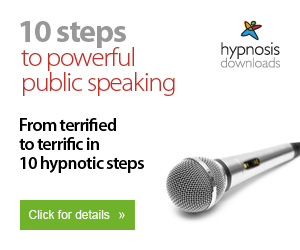Self Hypnosis Technique
What Is Your Favorite Self Hypnosis Technique?
 There are so many hypnosis techniques it would take a library to hold all the books about them. Each person and each situation is different and each one needs an individual approach for achieving the desired goal. What’s so nice about this is that if one thing doesn’t work, there are plenty more to try. A lot of times, self hypnosis is homework given after an in-office hypnosis session. During the session, the client is super relaxed as the therapist sitting nearby repeats positive affirmations aloud. These affirmations are specifically designed to meet the goals for the client’s situation. Any old negative subconscious programs related to the issue will be overridden by the new. The office session can be recorded and used for self hypnosis by the client.
There are so many hypnosis techniques it would take a library to hold all the books about them. Each person and each situation is different and each one needs an individual approach for achieving the desired goal. What’s so nice about this is that if one thing doesn’t work, there are plenty more to try. A lot of times, self hypnosis is homework given after an in-office hypnosis session. During the session, the client is super relaxed as the therapist sitting nearby repeats positive affirmations aloud. These affirmations are specifically designed to meet the goals for the client’s situation. Any old negative subconscious programs related to the issue will be overridden by the new. The office session can be recorded and used for self hypnosis by the client.
What is a Hypnosis Session Like?
As a hypnosis facilitator or therapist, I like to create an individualized session for each client. First the client calls for an appointment and says they want to stop smoking for an example. During the phone call we discuss when they want to stop. What day? We make the appointment for that day, if possible. We ask the person to bring all of their cigarettes with them, because when they leave the session they won’t need them any more. The first hypnosis to stop smoking session can be successful enough to stop smoking immediately.
During the initial interview, the therapist learns as much as she can about the client’s smoking habits such as when does the first smoke of the day happen? The client has to come up with a plan for dealing with that time of day without cigarettes. He has to know without a doubt what he will do instead of smoking. If the first cigarette of the day is smoked while drinking coffee and reading the paper at the kitchen table, the client will need a new habit for that time of day. A good substitution might be to go for a run or a walk instead. Hypnosis techniques are tailored for the individual depending upon what the issue is.
When the hypnosis facilitator has thoroughly explored the smoking behavior of the client and together they have come up with acceptable substitutions, the session can begin. The client is settled into a comfortable chair, told to close their eyes and relax. A simple relaxation technique is counting backwards from one hundred aloud. Usually the counting tapers off rapidly and the client enters a trance state.
Next the therapist leads the client to experience a life as a non smoker using the information gained during the interview. For instance, the client is told to experience how it feels to go for a run in the morning. Feel the wind, hear sounds of nature, see themselves running and getting stronger and more fit. The client can feel, see, hear, taste this better life as though it is totally real. The session lasts for about 40 minutes and when it’s over, the client will be a non-smoker. While you are a non smoker, you don’t smoke.
Listening to the recording of the session each night or more often if necessary, helps reinforce new behaviors for success. This is self hypnosis. You can take charge of your life and begin to do what you want, rather than what you don’t want. It’s all a matter of using self hypnosis and following through with your plans. You can always see a hypnotherapist for another session.
A paper by Dr. Charles T. Tart, presented at the 2001 American Psychological Association Conference talks about whether meditation is considered a type of hypnosis. His consensus is that meditation can require one to focus either upon thoughts or no thoughts. Even though hypnosis is similar to the altered state of awareness during meditation, hypnosis requires a studied redirection of the subconscious away from negative thoughts and habits. During hypnosis new neural pathways are formed which are more helpful to the person. Meditation is seemingly not so focused upon changing negative thought patterns but to clear the mind.
Click on the next link for Steps for Rapid Self Hypnosis detailed in a paper by Antonio Capafons at the Universitat de Valencia. Techniques to get a response from the client, such as, hand clasping with special breathing, falling backwards into a soft chair or sofa, chaining of the two steps, and body immobility help to induce rapid self hypnosis.




